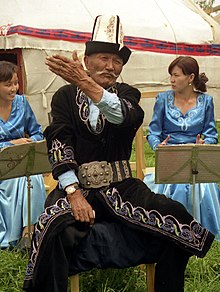Kalpak




Calpack, kalpak, or qalpaq (from Turkish: kalpak [kaɫˈpak];[1] Kazakh: қалпақ, Kyrgyz: калпак, both [qɑlˈpɑq]; Bulgarian: калпак; Greek: καλπάκι (kalpaki);[2] Polish: kołpak; Ukrainian: ковпак, kovpak) is a high-crowned cap (usually made of felt or sheepskin) worn by Circassians, Dagestanis, Chechens, men in Turkey, Ukraine, the Balkans and throughout Central Asia and the Caucasus.
The kalpak is used to keep the head warm in winter and shade out the sun during summer. There are different kalpaks for different seasons, with kalpaks used in winter being thicker and the ones used in summer being thinner but broader for shading purposes.
There are many styles of kalpak. They usually can be folded flat for keeping or carrying when not being worn. The brim can be turned up all the way around. Sometimes there is a cut in the brim so that a two-pointed peak can be formed. Plain white ones are often reserved for festivals and special occasions. Those intended for everyday use may have a black velvet lining. In the Turkic cultures of central Asia, they have a sharp tapering to resemble a mountain, rather than the cyndrical kalpaks of Turkey.
The word kalpak is also a component of the ethnonym of a Turkic group of uncertain relation: the "Karakalpak" (literally "black kalpak" in the Karakalpak language).
In Russian, Persian and Polish, the word is also used for hubcap (for a car wheel's hub; see also the Wiktionary entry hubcap).
See also[]
- Bashlyk
- Kolpik
- Phrygian cap
- Kurhars (ru:Курхарс)
- List of headgear
References[]
| Wikimedia Commons has media related to Kolpaks. |
- ^ "Merriam-Webster Online - Calpack entry". M-w.com. 2012-08-31. Retrieved 2014-06-03.
- ^ Dehèque, Félix Désiré (1825). Dictionnaire grec–moderne français (in French). J. Duplessis et Cie. p. 271.
καλπάκι, το, bonnet fourré [fur-lined cap]
External links[]
![]() The dictionary definition of calpack at Wiktionary
The dictionary definition of calpack at Wiktionary
- Caps
- Turkish clothing
- Russian clothing
- Turkish words and phrases
- Ethnic Kyrgyz culture
- History of Asian clothing
- Bulgaria stubs
- Central Asia stubs
- Turkey stubs